Purple martins are a bird of the people.
Throughout most of their range, martins are completely dependent on human-created nesting structures. Even beyond the nesting season, purple martins commonly establish roost sites in and around human-created structures.
It’s not clear when martins made the switch from natural nesting cavities to human-constructed purple martin houses.
Many writers suggest that Native Americans built purple martin houses and that the switch to human-made housing was underway before the arrival of Europeans in North America. Although this is entirely plausible, there isn’t much evidence that Native Americans are responsible for the bird’s transition from natural to human-made nest sites.
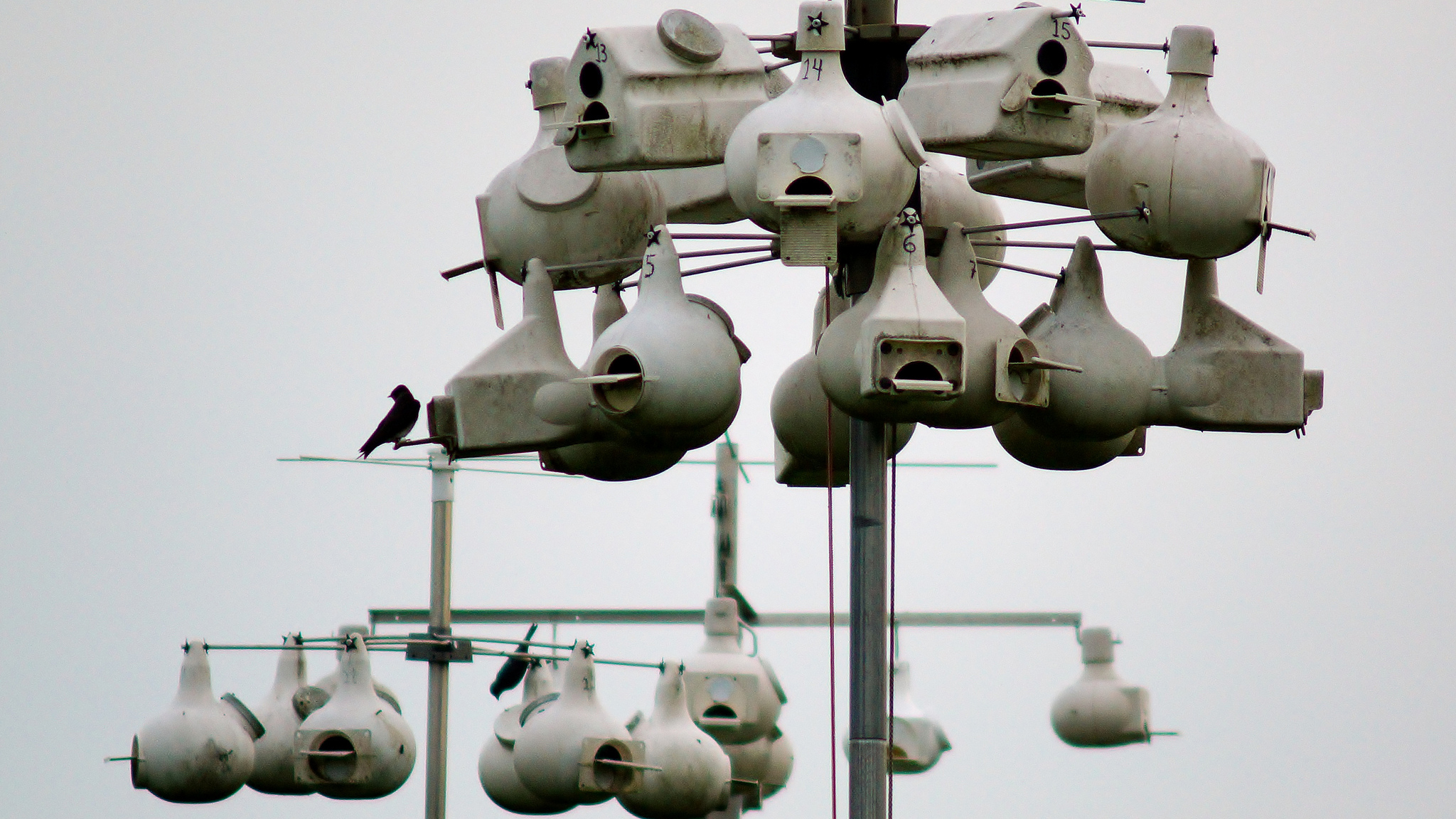
Early American ornithologists did mention seeing Native American-built gourd houses. But they made these observations well after Europeans settled in North America.
In his book American Ornithology (1808), Alexander Wilson implies that while visiting Choctaw and Chickasaw settlements during the late 1700s, he saw hollowed-out gourds for purple martins placed atop poles.
Even in the early 1700s, naturalist Mark Catesby noted that martin houses were a common sight in colonial farms and towns in the Carolinas.
By the time Wilson and Catesby made their observations, everyone had martin houses.
Should We Rename Them People Martins?
Equally unclear is why people became interested in providing martins a home.
Some potential benefits offered by early observers are that the birds reduced the general bugginess around human habitation and that the martins protected barnyard fowl by mobbing and chasing hawks.
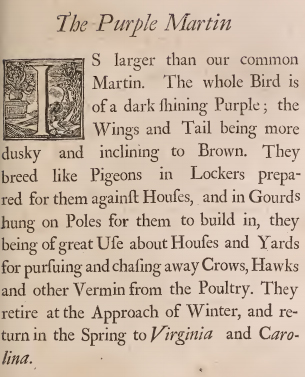
The popularity of providing homes for martins in modern times may stem from the mistaken belief that they are effective at controlling mosquitoes.
A dubious factoid, stated and restated over decades, asserts that, “a single martin eats 2,000 mosquitoes per day.”
Herbert Kale set the record straight in his 1968 article in the journal The Auk, demonstrating that there was no evidence that purple martins eat very many mosquitoes.
He pinned the blame for the false factoid on J.L. Wade, a businessman who “made a fortune building pole-top condominiums for purple martins.”
According to his 2007 obituary in the Wall Street Journal, Wade was so fond of the “2,000 mosquitoes” claim that he changed the last four digits of his phone number to “2000.” Despite false advertising, Wade is remembered as a tireless advocate for purple martins (and for martin houses!).
What do martins really eat? Everything but mosquitos, it seems. They eat a wide variety of larger-flying insects including beetles, flies, dragonflies, grasshoppers, wasps and bees.

Recent research has revealed that martins do provide an important insect control service after all. They hoover up as many flying fire ant queens as they can. A 2016 study revealed that fire ants comprise 56% of all items consumed by martins at study site in Oklahoma.
Fire ants were introduced from South America and are now common throughout the southeast United States. Among other undesirable attributes, fire ants build mounds that dot lawns, fields and pastures. Whenever a mound is disturbed, the ants attack en masse with painful stings.
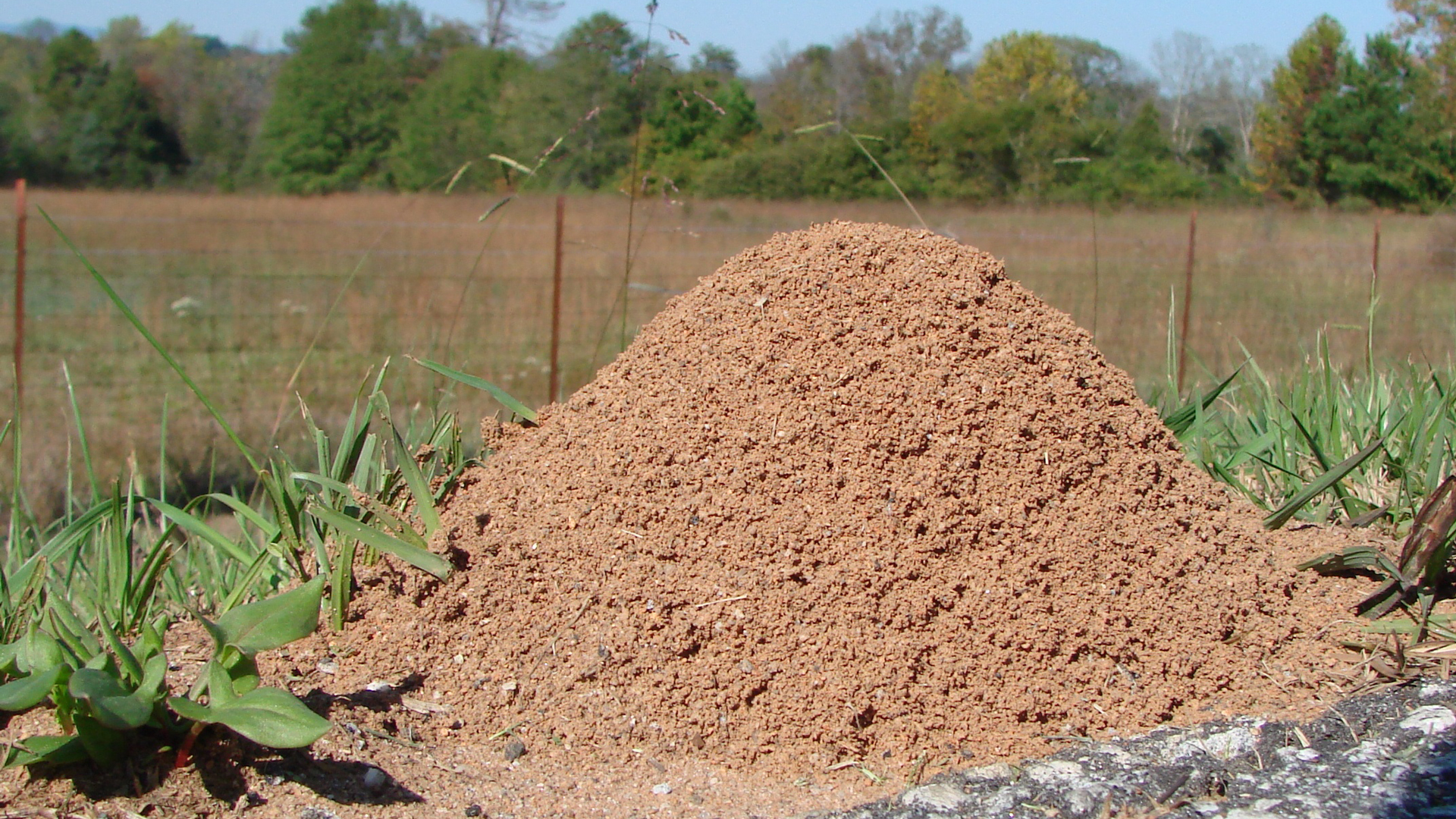
Each queen a purple martin scarfs up means one less pestilential mound of cranky ants on the lawns of Dixie.
Urban Martins
Beyond the nesting season, purple martins remain a bird of the people.
After nesting and prior to migrating, thousands of martins gather to roost in such places as bridges, powerline structures and trees in parking lots, along with locations in more natural settings.
Roosts are a dramatic and easily observable wildlife spectacle in mid to late summer – especially at dusk when the birds arrive and whoosh by the thousands into the roost site. If you live in the eastern U.S. it’s very likely that one of these roosts is close by. Check this map of roost sites, courtesy of the Purple Martin Conservation Association.
In 1903, P.A. Taverner described a roost in Chicago that formed at the corner of Washington Square Park. He writes that “in all of Chicago, I know of no spot that would seem more unlikely to be used for such a purpose.” He goes on to describe the scene:
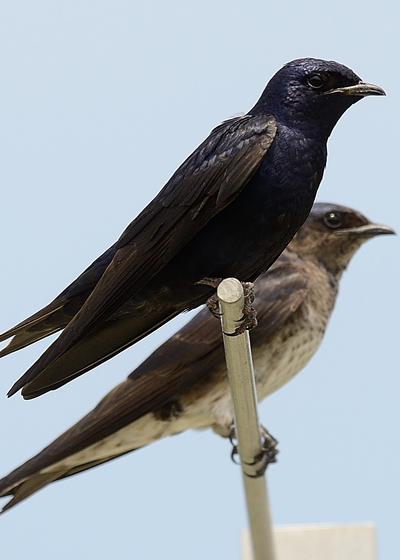
“On the avenue is a double line of noisy, clanging, banging cable cars, running a three-minute service. Diagonally across there were a number of pop-corn stands, gypsy fortune tellers with their array of gasoline jacks and the usual quota of loafers. Automobiles, delivery wagons, trucks, and all manner of vehicles are continually passing, and the street is generally well filled evenings, with a throng of saunterers, sightseers and loafers.”
Purple martins seem almost attracted to people. Even after migration to Brazil, where most purple martins spend the winter, their habit of roosting in and around human-made structures continues.
David Attenborough profiled such behavior in the The Life of Birds documentary series. He shows that even in the heart of the Amazon rainforest, the martins chose to roost in an oil refinery.
Throughout Brazil, martins frequently roost in cities and towns. But this behavior doesn’t seem to be as celebrated in Brazil as it is in the U.S.

The difference in perspective is related to time scale.
In the United States, big communal roosts of martins are ephemeral, lasting only for a few weeks in the period prior to migration.
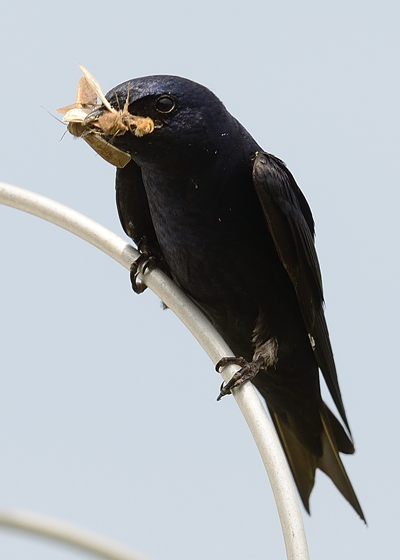
But in Brazil, the roosts can last for six months. Imagine six months’ worth of nightly excrement production from thousands of birds. Too much of a good thing can become a perplexing public nuisance.
News reports talk of municipalities needing dump trucks to haul away the excrement and feathers that accumulate over the course of months.
The toll that martins take on a public park can be seen in this Brazilian news video.
The people being interviewed (understandably) complain of the sight and smell of a city park piled high with bird dung. A researcher muses on the public health risk of the bird waste and the commentator wonders if there isn’t a way to scare the purple martins off to make them move to another location.
In another Brazilian city 600 miles away, the same problem and the same complaints are profiled. This report is more balanced, with the commentator expressing wonder at the spectacle of thousands of birds arriving from far off places.
In yet another news story, there are reports of ruined car paint and a schoolyard polluted with martin poo. The local government promises solutions.
Out of the sight and minds of its fans in North America, the purple martin faces a public relations problem in South America. Some people there wish the birds didn’t have such a great affinity for towns and cities.
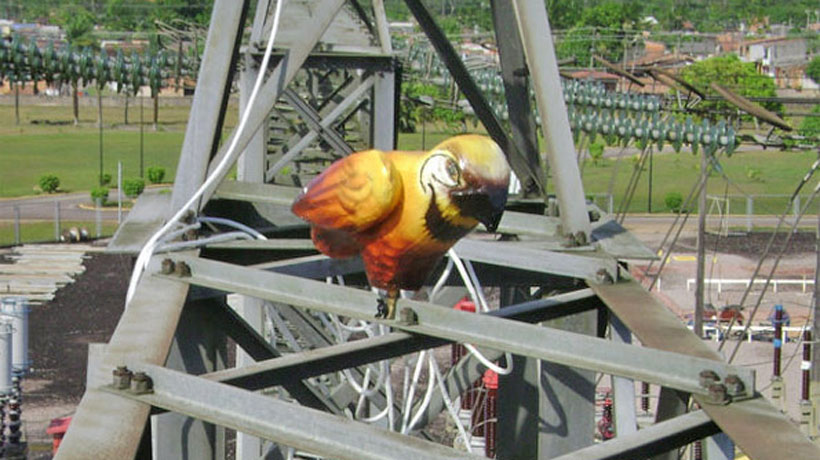
Martin Conservation Goes Beyond Bird Houses
Divergent perspectives regarding purple martins between North and South America remind us that conservation of migratory birds needs to take full view of their life cycle. It seems important to know what proportion of Brazilian martin roosts occur in places that cause problems for people. This is especially true if some of these roosts are being disturbed out of sanitation concerns. In that case, we also need to know what impact roost disturbance has on martin populations. As in the United States, purple martins are protected by federal law but indirect actions are permitted to discourage roosting, such as erecting scarecrows or exclusion netting.
Although we continue to learn more and more about the lives of purple martins, big questions remain unanswered. How did our own cultural practice of building martin houses emerge and how did martins become so utterly dependent on us? And what benefits are gained for purple martins by cozying up to roost in powerlines, refineries and city parks?
Purple martins are among our most studied and beloved backyard birds, and yet the reasons behind their unfaltering affinity for the human landscape remains a great mystery.
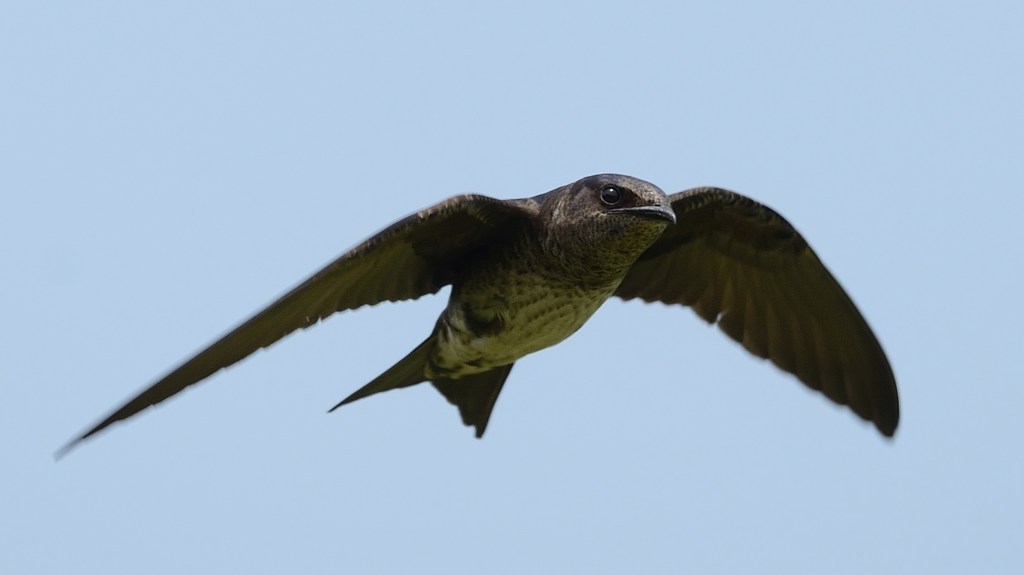



I live in Fort Myers Florida. I bought new purple Martin houses, but I’m not attracting any birds. In my old houses every year they were full. This year no birds. I wonder if you have an answer for that. The houses are the standard gourds.
The North American roosts are not as ephemeral as your article suggests. In Austin, Texas, our roost begins sometime in June. We haven’t been able to pinpoint the exact start time as the roost initially starts quite small. It could even be in early June, as the first local Martins are already out of the nest by May. But it soon grows until by about July we have hundreds of thousands. Dozens of people come out to watch. The number begins to dwindle through August and we have found birds at least through the first week in September. So, I’d revise “weeks” to “months.” Perhaps the length of the roost varies in points further north.
One point in which the occupation is ephemeral is that the PMCA has tagged birds and discovered that most individuals spend only a few days at each roost. The martins appear to be using them more as waypoints on a journey, rather than a giant growing gathering that suddenly shrinks in one big push.
Thanks for your article, as it does point out the need to educate people on both continents about the benefits of the birds, and why their roost should be accommodated and tolerated.
In Austin, we organize a community of volunteers who go around to local businesses affected by the roost and its droppings, and talk to them about the birds. We also offer to clean up the poop, as well as look for injured and dead birds every morning. The injured birds go to wildlife rescue, while the dead birds are sent to a local university for scientific study.
Do I need to add cedar shaving to my Martin bird apartment to attract them in Maine.
Thank you for this article. I especially enjoyed the part about P.A Taverner. I live in Chicago, and recently our neighbor erected one of those towers with the Martin pods. I was curious and started searching google for what they are. Well, I found out what they were and also found this article. Talk about learning something new. Oh and the part about Brasil, was great too because I am a Brasilian living in Chicago, with a neighbor that set up Martin houses … lol. What a coincidence.
I have a Purple Martin house which was put up in 2000. I lower it every fall and clean out the
“apartments” every spring before put it back up. This time I noticed (fist time ever) the pull
cord section (inside the house area) had been chewed away for the soft nesting usage. Here is
my question and challenge. The steel pole is in concrete and I want to replace the up/down
pull cord. Thank you, Bob McColm, caminobob@comcast.net, 61 Moonridge Lane,
Harpers Ferry, WV 25425
HI NI LIVE IN CENTRAL, Va. I 1st put up a 12 Compartment Purple MarTIN HOUSE LAST YR WITH 6 Gourds ON THE RITE SIDE OF THE MARTIN HOUSE. THIS YR, I’ve had SOME MARTINS GO IN & OUTTA THE HOUSE/GOURDS FOR THE LAST WEEK OR SO. SOMETIMES FOR A SHORT PERIOD OF TIME & SOME MOST OF THE DAY. 1OF THE MARTINS FRM A PAIR HAS BEEN LANDING ON THE GROUND GETTING TWIGS & TAKING THEM BACK TO THE HOUSE & GOURDS. I JUST PUT UP A 3RD MARTIN 16 COMPARTMENT HOUSE. THE MARTINS HAVE LANDED, CAME, & LEAVE. THEY GO INSIDE OF THE HOUSE & GOURDS. THE QUESTION I Have IS : WHEN WILL I ACTUALLY KNOW IF THEY R GONNA STAY & NEST AT MY HOUSING?
I’m trying to PATIENTLY WAIT & SEE BUT IT’S KILLING ME TO WAIT & FIND OUT.
IS THERE ANY1 THAT CAN GIVE ME SOME INSIGHT, ADVICE PLZ ????
I have been Praying that this yr my Martin Colony will be a SUCCESSFUL 1.
Email me back @ mamalu69@yahoo.com ASAP.
Thanks.
Lucy
Hi Lucy, Thank you for your comment and for putting up Purple Martin houses! I think that this FAQ from the Purple Martin Conservation Association will answer your questions: https://www.purplemartin.org/education/24/faq/ If you have more questions that are not answered there, I think their forum would be a good place to ask and get advice from people who have faced the same challenges: https://www.purplemartin.org/forum/
I love your reading so much can you put your story on hear so more or who ever put the story and the videos and send them to my computer and I will read them all and send you a message about your birds and animal and through out America thank you for letting me read about the things you do